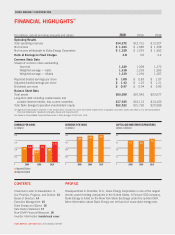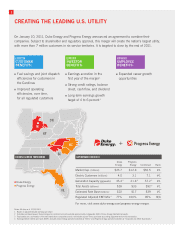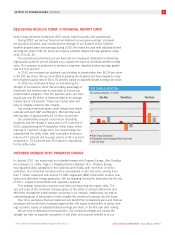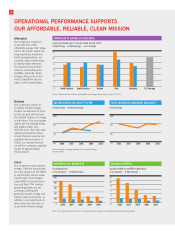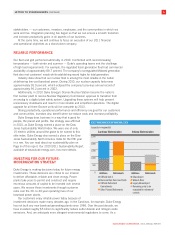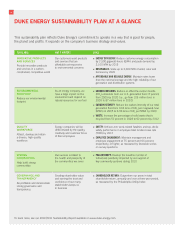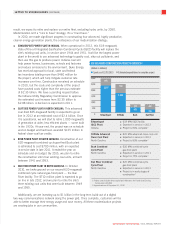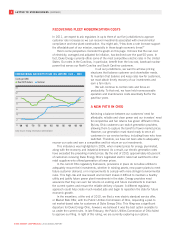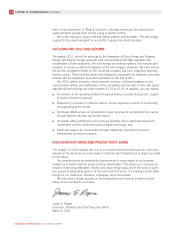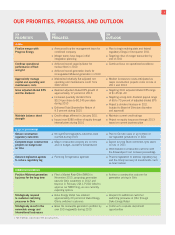Duke Energy 2010 Annual Report Download - page 10
Download and view the complete annual report
Please find page 10 of the 2010 Duke Energy annual report below. You can navigate through the pages in the report by either clicking on the pages listed below, or by using the keyword search tool below to find specific information within the annual report.
LETTER TO STAKEHOLDERS (CONTINUED)
RECOVERING FLEET MODERNIZATION COSTS
In 2011, we expect to ask regulators in up to three of our five jurisdictions to approve
customer rate increases so we can recover investments associated with environmental
compliance and new plant construction. You might ask, “How does a rate increase support
the affordable part of our mission, especially in these tough economic times?”
Here’s some perspective: Consider the graph on this page. It shows that the real cost
of electricity, averaged and adjusted for inflation, has declined over the past 50 years. In
fact, Duke Energy currently offers some of the most competitive electric rates in the United
States. Our rates in the Carolinas, in particular, benefit from the low-cost, baseload nuclear
power that serves our North Carolina and South Carolina customers.
In all our jurisdictions, we want to achieve pricing
structures that balance customer and shareholder needs.
To maintain that balance and keep rates low for customers,
we must obtain timely recovery of our investments and
earn a fair return.
We will continue to control costs and focus on
productivity. To that end, we have held nonrecoverable
operation and maintenance costs essentially flat for the
past four years.
A NEW PATH IN OHIO
Achieving a balance between our customers’ need for
affordable, reliable and clean power and our investors’ need
for competitive and fair returns has grown difficult in Ohio.
By law, Ohio customers can switch generation providers,
allowing them to capture the benefit of lower market prices.
However, our generation must stand ready to serve all
customers in our service territory, including those who have
switched. Therefore, we have not been able to adequately
recover our costs and earn a competitive and fair return on our investments.
This imbalance was highlighted in 2009, when market prices for energy plummeted,
along with the economy and industrial demand. As a result, our electric generation rates
have exceeded the prevailing market prices. By the end of 2010, approximately 65 percent
of customers receiving Duke Energy Ohio’s negotiated electric rates had switched to other
retail suppliers who offered generation at lower prices.
In the current Ohio regulatory framework, provisions in place do not allow utilities to
adequately recover their investments, whether in existing assets, new power plants to meet
future customer demand, or in improvements to comply with more stringent environmental
rules. This high-risk and low-reward environment makes it difficult to maintain a healthy
utility and justify future power plant investments in the state. Energy providers need
assurance that they can earn fair returns on existing and future investments to maintain
the current system and ensure the reliable delivery of power. A different regulatory
approach could help create much-needed jobs and begin to reposition the state for future
economic growth.
In the meantime, at the end of 2010, we filed a new electric standard service offer,
or Market Rate Offer, with the Public Utilities Commission of Ohio, requesting a plan to
set market-based rates for customers of Duke Energy Ohio. This filing was a significant
departure for Duke Energy Ohio, however, we believed it was the best option available to
us under the current rules. In late February, the Public Utilities Commission of Ohio failed
to approve our filing. In light of this ruling, we are currently exploring our options.
AVERAGE ANNUAL ELECTRICITY PRICES (ALL SECTORS), 1960 — 2009
(cents per kWh)
Real 2005 Dollars Nominal
14
12
10
8
6
4
2
0
Data Source: Energy Information Administration
‘60 ‘65 ‘70 ‘75 ‘80 ‘85 ‘90 ‘95 ‘00 ‘05 ‘09
8
DUKE ENERGY CORPORATION / 2010 ANNUAL REPORT


